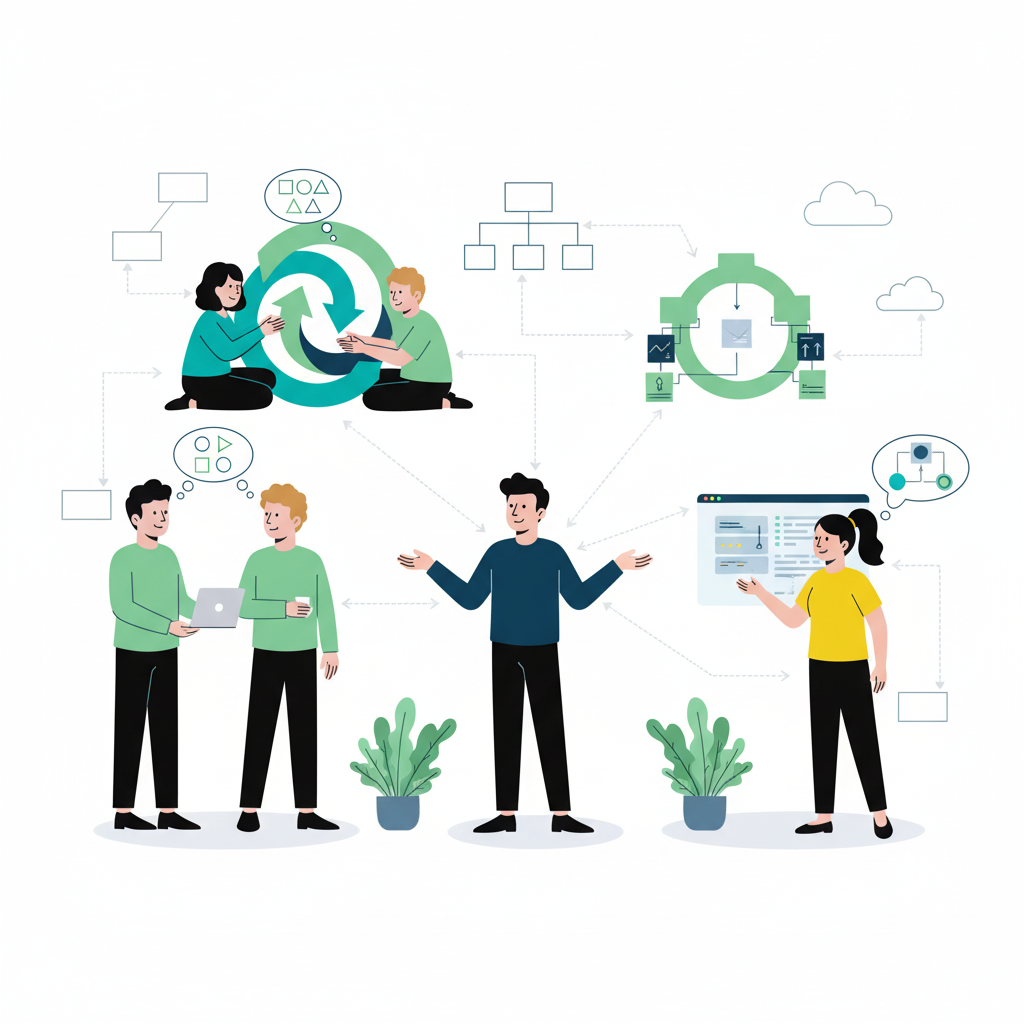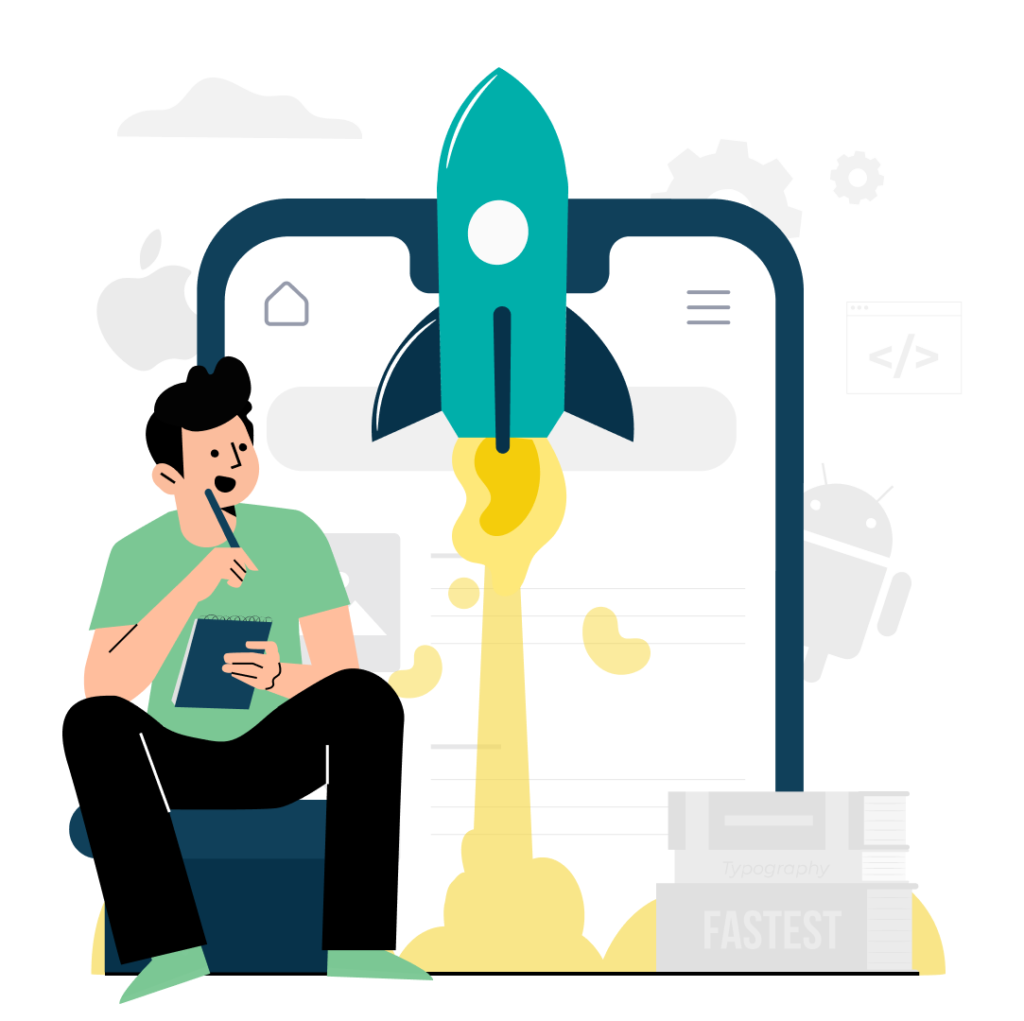Engineering organisations struggle with increasing complexity that overwhelms teams and slows delivery. Team cognitive load refers to “the collective cognitive burden experienced by a group working together,” and cognitive overload costs organisations $322 billion annually in lost productivity. Team organisation patterns based on Conway’s Law and cognitive load principles offer a systematic approach to structuring teams for optimal performance.
This guide is part of our comprehensive engineering effectiveness framework that explores how teams transcend cognitive limitations through strategic thinking. Here we examine how to distribute cognitive load across engineering organisations using stream-aligned teams, platform teams, enabling teams, and complicated subsystem teams. You’ll learn practical patterns for organising teams to minimise cognitive overhead, reduce dependencies, and accelerate autonomous delivery. These organisational design principles help growing tech companies scale their engineering effectiveness while maintaining technical excellence and team empowerment.
What is cognitive load in software development teams?
Cognitive load is the finite mental capacity teams have for processing information, learning, and problem-solving. Understanding cognitive load fundamentals provides the scientific foundation for team organisation decisions. In software development, teams face three distinct types of cognitive burden that directly impact their effectiveness and delivery capability.
Intrinsic cognitive load represents the inherent complexity of the problem domain itself—the difficulty of understanding business requirements, technical constraints, and user needs. This type of load is unavoidable and necessary for delivering value.
Extraneous cognitive load stems from poor tooling, inefficient processes, unclear communication channels, and environmental distractions. This represents wasted mental capacity that doesn’t contribute to value creation. Research shows that teams experiencing high cognitive load demonstrated a 76% correlation with burnout rates and 68% correlation with turnover intention.
Germane cognitive load involves learning and knowledge building activities that help teams develop better mental models and problem-solving capabilities. This type of load is valuable as it builds long-term team capability.
The impact of cognitive overload manifests in several measurable ways. Teams report decreased code quality, slower delivery cycles, increased context switching, and reduced job satisfaction. Communication overhead grows non-linearly as team size increases, following principles similar to Dunbar’s number for social group dynamics.
Effective team organisation minimises extraneous cognitive load while preserving capacity for valuable problem-solving and innovation. This requires deliberate design of team structure, interaction patterns, and supporting systems rather than allowing organisational complexity to emerge accidentally.
How does Conway’s Law affect team organisation and software architecture?
Conway’s Law states that “any organisation that designs a system will produce a design whose structure is a copy of the organisation’s communication structure.” This principle, formulated by Melvin Conway, reveals how team boundaries directly influence API design, service boundaries, and system coupling.
The law manifests in predictable patterns across software development. If a single team writes a compiler, it will be a one-pass compiler, but if the team is divided into two, then it will be a two-pass compiler. Similarly, teams organised by technology layers consistently produce problematic layered architectures that require cross-team coordination for simple feature changes.
Physical and organisational distance amplifies these effects. Putting teams on separate floors reduces communication; separate cities and time zones further limit regular conversation. This directly impacts software coupling, as software coupling is enabled and encouraged by human communication.
Understanding this relationship allows technical leaders to use the Inverse Conway Manoeuvre—deliberately organising teams to encourage desired software architecture rather than accepting accidental complexity. This approach involves deliberately altering development team organisation to encourage desired software architecture.
The key insight is that organisational structure isn’t neutral—it actively shapes technical outcomes. Building small, long-lived business capability-centric teams containing all skills needed to deliver customer value results in more modular, maintainable architectures.
What are the four fundamental team types in Team Topologies?
Team Topologies defines four team types, each serving specific purposes in distributing cognitive load and creating autonomous delivery capabilities across organisations.
Stream-aligned teams are aligned to specific value streams, delivering direct customer value. These teams are responsible for a single business capability, full-stack and full-lifecycle. They own their entire technology stack from development to operations, minimising external dependencies and maximising autonomous delivery capability.
Platform teams provide internal services to accelerate stream-aligned teams’ delivery. They build internal platforms to reduce cognitive load, providing self-service infrastructure. Platform teams act as internal service providers, creating compelling APIs, tools, and services that abstract infrastructure complexity from stream-aligned teams.
Enabling teams help stream-aligned teams overcome obstacles and develop capabilities. These are specialists who help other teams develop skills through coaching, focusing on knowledge transfer and capability building rather than permanent support. Enabling teams are temporary interventions designed to build autonomy in other teams.
Complicated subsystem teams handle complex technical components requiring specialised expertise. These teams focus on complex technical subsystems, reducing cognitive load for stream-aligned teams by owning domains that would otherwise overwhelm generalist teams with excessive technical complexity.
The model is intentionally constrained to encourage organisational evolution and effectiveness. Each team type has specific sizing recommendations following optimal communication principles for manageable cognitive load.
How do stream-aligned teams differ from traditional development teams?
Stream-aligned teams represent a shift from traditional organisational patterns, focusing on business capabilities rather than technical functions. Unlike conventional teams organised around technology layers, stream-aligned teams are organised around business capabilities rather than technology layers.
Traditional technology layer teams (UI, server-side, database) create coordination overhead and cognitive burden. These structures lead to cross-team projects requiring time and budgetary approval, forcing teams to coordinate extensively for simple changes.
Stream-aligned teams take broad-stack implementation including user-interface, persistent storage, and external collaborations. They are cross-functional teams that include the full range of skills: user-experience, database, and project management. This comprehensive skill coverage enables autonomous decision-making and rapid value delivery.
The business capability focus provides significant advantages. Teams organised by business capabilities can develop expertise in their specific domain area, enabling deeper understanding of customer needs and business context. They can make decisions quickly without coordinating with other teams and can choose technology stack that best fits their domain.
This autonomy enables stream-aligned teams to release software independently from other teams, dramatically reducing delivery cycles and coordination overhead. Service boundaries should be reinforced by team boundaries, creating clear ownership and reducing cognitive load through well-defined interfaces.
What is the purpose of platform teams in reducing cognitive load?
Platform teams serve as internal service providers, creating compelling internal products that abstract infrastructure complexity and operational overhead from stream-aligned teams. Their primary purpose is reducing cognitive load on developers to enable them to go faster through self-service capabilities and automation. This approach aligns with our transcending cognitive limitations framework for building organizational effectiveness. For detailed guidance on building these capabilities, see our platform engineering implementation guide.
The platform-as-a-product mindset distinguishes effective platform teams from traditional IT support. Platform engineers collaborate closely with developers, supplying tools and resources to boost productivity while treating stream-aligned teams as internal customers with specific needs and satisfaction metrics.
Platform teams design and build self-service tools and workflows like CI/CD pipelines and infrastructure provisioning. They establish and ensure best practices for software development and delivery, creating standardised approaches that reduce extraneous cognitive load across the organisation.
The Developer Experience (DevEx) focus is central to platform team success. This involves providing automation and self-service experience for developers while maintaining appropriate abstraction levels that hide complexity without limiting capability.
Effective platform teams provide self-service capabilities across multiple domains: deployment automation, monitoring and observability, data services, security and compliance, and development environment provisioning. They integrate third-party services and internal services into cohesive, easy-to-consume platforms that reduce cognitive burden on stream-aligned teams.
Success metrics for platform teams focus on adoption rates, stream-aligned team satisfaction scores, reduction in support tickets, and measurable improvements in deployment frequency and lead time.
When should you create enabling teams for capability building?
Enabling teams are temporary specialists who address specific capability gaps through knowledge transfer and coaching rather than permanent support. Create enabling teams when stream-aligned teams face skill gaps, new technology adoption needs, or capability building requirements that exceed their current cognitive capacity.
Unlike permanent support teams that create dependency, enabling teams focus on building capability within other teams and then disbanding once knowledge transfer is complete.
Common scenarios requiring enabling team intervention include new technology adoption, domain expertise gaps for regulatory compliance or security requirements, and practice improvement for development practices, testing strategies, or operational procedures.
The key distinction is that enabling teams help stream-aligned teams become more autonomous rather than creating ongoing dependency. They use facilitating mode for coaching-oriented interaction, working directly with teams to transfer knowledge and build internal capability.
Successful enabling team engagements have explicit exit criteria and knowledge transfer goals. They measure success through capability improvement in the target teams rather than ongoing utilisation.
Enabling teams should have deep expertise in their domain, strong coaching and knowledge transfer skills, and ability to work across multiple teams simultaneously. This expertise sharing connects directly to effective knowledge systems for distributed teams that reduce cognitive burden through systematic knowledge capture and distribution.
What are the three team interaction modes and when to use each?
Team Topologies defines three explicit interaction modes that optimise cognitive load distribution and organisational effectiveness. Each mode serves different purposes and should be consciously chosen rather than left to emerge accidentally.
Collaboration mode involves working closely together to discover new things. This is intensive partnership, typically temporary when developing new services. Use collaboration mode during innovation phases, when exploring new domains, or when teams need to jointly solve complex problems requiring shared expertise.
X-as-a-Service mode involves one team providing services while another consumes with minimal interaction. Platform teams provide services with minimal collaboration, while stream-aligned teams use platform independently. This mode optimises for efficiency and cognitive load reduction when requirements are well-understood and interfaces are stable.
Facilitation mode involves one team helping and mentoring another team. This coaching-oriented interaction is used by enabling teams to transfer knowledge and build capability in other teams. Use facilitation mode when addressing skill gaps, implementing new practices, or building long-term capability.
The choice of interaction mode significantly impacts cognitive load. Simplifying communication helps reduce the team’s cognitive load by providing clear protocols and expectations.
Interaction modes should evolve over time as teams mature and circumstances change. Limiting interaction is important because noise in communication can be a distraction. Teams should adjust interaction levels to what each team desires and can sustainably manage within their cognitive capacity.
How do you measure cognitive load distribution success in teams?
Measuring cognitive load distribution success requires combining quantitative metrics with qualitative indicators to create a comprehensive view of team effectiveness and sustainability.
Systematic data gathering combines regular team assessments with performance metrics analysis and qualitative feedback. This multi-faceted approach recognises that measuring team cognitive load directly remains elusive; focus on identifying and managing key drivers.
Quantitative metrics include interrupt frequency, context switching indicators, deployment frequency, lead time for changes, and mean time to recovery. These objective measures reveal patterns of cognitive burden and delivery effectiveness. Teams with well-managed cognitive load demonstrate higher job satisfaction and better performance outcomes.
Qualitative indicators focus on team satisfaction, stress levels, learning capacity, and perceived autonomy. Regular team health surveys, retrospective feedback, and structured interviews provide insights into subjective experiences of cognitive load.
Organisations focus on four key areas: team structure optimisation, process improvements, technology enhancements, and environmental modifications. Success in cognitive load distribution shows balanced workload across teams, reduced cross-team dependencies, faster delivery cycles, and sustained team wellbeing without burnout symptoms. These measurement approaches connect to broader measuring team effectiveness frameworks that validate organisational improvements. The systematic approach to measuring and optimizing cognitive load is central to our strategic platform thinking methodology for engineering excellence.
Implementation approaches should start with simple monitoring practices, gradually building more sophisticated management approaches. The most successful organisations treat cognitive load management as a continuous process rather than one-time initiative.
Organisations successfully leveraging AI report up to 40% reduction in routine cognitive load, suggesting that automation can effectively reduce extraneous cognitive burden.
FAQ Section
How long does it take to implement Team Topologies in a growing organisation?
Expect 6-12 months for meaningful transformation, with initial improvements visible within 3 months of focused implementation. The timeline depends on current organisational complexity, team maturity, and leadership commitment to change management.
What mistakes do new CTOs make when reorganising engineering teams?
Common mistakes include reorganising too frequently, ignoring skill gaps, creating too many dependencies, and failing to measure cognitive load impact. Avoid attempting wholesale changes simultaneously; instead focus on iterative improvements with clear success metrics.
How do Team Topologies compare to the Spotify model?
Team Topologies provides more systematic cognitive load focus and explicit interaction patterns, while the Spotify model emphasises cultural elements without specific organisational design principles. Team Topologies offers concrete frameworks for measuring and optimising team effectiveness.
What team size works best for cognitive load optimisation?
Teams of 5-9 people optimise cognitive capacity while maintaining effective communication, following Dunbar’s number principles for social group dynamics. Communication overhead grows non-linearly as team size increases, making smaller teams more cognitively efficient.
How do I know if my team structure is causing communication problems?
Warning signs include frequent coordination meetings, unclear ownership boundaries, repeated escalations, teams waiting on other teams for delivery, and increasing context switching. Technical infrastructure reliability issues can also indicate underlying organisational problems.
When should I create a complicated subsystem team?
Create complicated subsystem teams when domain complexity requires specialised expertise that would overload stream-aligned teams with extraneous cognitive burden. Examples include complex algorithms, regulatory compliance systems, or highly specialised technical domains.
What skills do platform teams need that other teams don’t?
Platform teams need product management skills, internal customer research capabilities, and expertise in building self-service tools and developer experiences. They must understand both technical implementation and user experience design for internal products.
How do I measure if platform teams are actually reducing cognitive load?
Track platform adoption metrics, stream-aligned team satisfaction scores, reduction in support tickets, increased autonomous delivery capabilities, and improved deployment frequency. Developer Experience metrics provide direct insight into cognitive load reduction.
What happens if enabling teams become permanent support teams?
This creates dependency and increases cognitive load rather than building capability—enabling teams must have explicit exit criteria and knowledge transfer goals. Permanent support relationships undermine team autonomy and create bottlenecks.
How do Team Topologies align with microservices architecture?
Team boundaries should align with service boundaries to minimise coordination overhead and enable autonomous service ownership by stream-aligned teams. This alignment supports Conway’s Law principles and reduces cognitive load through clear ownership.
What organisational changes are needed beyond team structure?
Supporting changes include funding models, performance metrics, communication tools, and leadership behaviours that reinforce team autonomy and cognitive load optimisation. Technology enhancements, process improvements, and environmental modifications all contribute to success. For the complete organizational effectiveness approach, see our comprehensive framework for transcending cognitive limitations through strategic platform thinking.
How do I get executive buy-in for team topology transformation?
Focus on business outcomes: faster delivery, reduced coordination overhead, improved quality, and better talent retention through reduced cognitive overload. Present data showing the correlation between cognitive load and business metrics like turnover and productivity.












